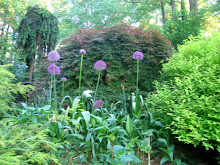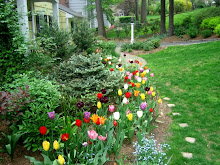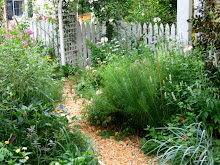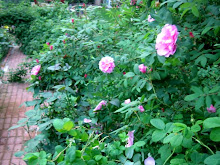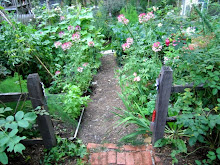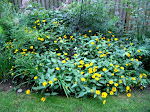"Uno Kivistik was born in 1932 in Estonia, in a medium landowner family who run their farm renownedly well. After the Soviet occupation, in 1949 they, just like everyone else, were deprived of their estates which were turned into Soviet-type kolkhozes..."
For the full story, click here: http://riowang.blogspot.com/2008/01/clematis-sociology-2-uno-kivistik.html
Welcome to Heirloom Gardener
Wednesday, January 30, 2008
An Inspirational Story About Clematis: Uno Kivistik of Estonia
Posted by
Julia Erickson
at
10:01 PM
3
comments
![]()
![]()
Labels: Clematis, Gardening Blogs
Monday, January 28, 2008
My Love Affair with Clematis: Inspiration from Raymond Evison and Barbara Packer
I never liked clematis. Everyone in my neighborhood had the perfunctory clematis draping their mailbox. They were beautiful in bloom, but later did nothing for the mailbox.
Then in 2004, I met Raymond Evison at the Philadelphia Flower Show and I fell in love. Mr. Evison is one of the world's foremost experts on and hybridizers of clematis. He has been growing clematis his entire life and produces somewhere around twenty five percent of all clematis sold in the world. Some pictures from his presentation at the Philadelphia Flower Show can be seen here: http://philadelphia.about.com/library/gallery/bl2004fs197.htm
The enduring lesson I learned from Mr. Evison is that clematis can and should be grown with other plants. The vines are gorgeous when in bloom, but are not so interesting otherwise. With this simple principle, the possibilities are endless: clematis with roses, clematis with shrubs, clematis with trees, clematis intertwined with perennials, and even clematis with ground covers.
I probably now have around 100 clematis throughout my garden and I feel like I'm just beginning my collection--there are so many spaces for clematis. Clematis offer such a range of color, vigor, and bloom time that every garden could find more spaces for clematis. Each time I plant a shrub, I usually plant a clematis along with it. Lilacs, for example, are dull most of the year; by adding a clematis that blooms later like 'Venosa Violacea' (heirloom 1883), you have two seasons. Or clematis 'Madame Julia Correvon' (heirloom pre-1900)blooms at the same time as caryopteris creating a great dark pink and blue combination. Herbaceous clematis from the intergrefolia group like 'Hakuree' can be planted to weave in and out of perennials. If you have a shady spot you wish to brighten, many of the lighter colored clematis actually preform better there than they do in full sun. The part sun will not reduce their blooming power and will make the color of the flowers more vibrant. Two good clematis for part sun and northern exposures are 'Dawn' and 'Asao.' On a low evergreen, the upward facing, vase shape blooms of the 'Texensis Viorna' group are beautifully set off.
Some people shy away from clematis thinking that they are difficult to prune and grow. If you don't want to deal with pruning decisions buy clematis in group 1 which don't need pruning or in group 3 which you cut back to two to three buds in the late winter. As for growing, if planted deeply--at least two to three inches deeper than they are in the container--success is almost assured. Clematis have a remarkable ability to regenerate from underground shoots. I have had vines that look like they have not made it through a transplant or have fallen victim to clematis wilt that come back later in the season or the following one. Once chosen and planted well, just fertilize and keep well watered.
If Mr. Evison was not enough inspiration, in August 2007, The New York Times wrote about Barbara Packer and "The Climbery, her seven-acre clematis garden...near Livingston, N.Y., in Columbia County. With 600 varieties and 6,000 vines, it’s the largest private clematis collection in the world, according to the International Clematis Society." Like many of us, Ms. Packer is not a professionally trained gardener, but this is no encumbrance to her being passionate about her garden. If you are reading his blog, I'm sure you know what I mean. For the full article, click here: http://www.nytimes.com/2007/08/31/travel/escapes/31away.html?pagewanted=all
For a prior post about the Betty Corning clematis on my arbor, click here: http://heirloomgardener.blogspot.com/2008/01/two-perfect-flowering-plants-for-arbors.html
The pictures below are: 'Ville de Lyon' (heirloom 1899) growing in full son on Goldberry Hill; 'Asao' growing in shade under our deck; and 'Etoile Violette' (heirloom pre-1885) growing in full sun on the deck.


Posted by
Julia Erickson
at
10:30 PM
7
comments
![]()
![]()
Labels: Clematis
Saturday, January 26, 2008
Front Border in Summer & Plan for the New Path
To help me plan for this coming gardening season, I am going through some of my pictures from last year. Here are some of the Front Border from last summer. The Front Border is a mixed border.
One of this year's projects will be to fix the path that runs from the driveway to the front door. The path has two problems. The first is that some of the stones that make up the path have started to sink and the path is becoming hazardous to visitors. This is a relatively minor problem compared to the second. The second problem is that the path is in the wrong place. From the street, you walk down the steps through Goldberry Hill. At the bottom of the steps, you want to walk directly across the driveway, across the grass, and to the front door. This is where the path should be. Instead of this route, the path requires you to make a right turn down the driveway about twenty feet and then a sharp left turn around the light post (you can see this in the last picture).
The solution will be to create the direct path that does not exist with a continuation of the steps and stones that already exist on Goldberry Hill. You can see the steps on Goldberry Hill here: http://heirloomgardener.blogspot.com/2008/01/gardening-on-hill-goldberry-hill-in.html
Follow-up post: Heirloom Gardener's Four Year Front Garden Makeover, including pictures of the new path




Posted by
Julia Erickson
at
12:03 PM
11
comments
![]()
![]()
Labels: Fences Arbors Walls and Paths, Front Border, Garden Bloggers' Design Workshop, Summer Garden
Thursday, January 24, 2008
Two Perfect Flowering Plants for Arbors: Betty Corning Clematis and Dortmund Rose
 My favorite of all plants to grow on an arbor is the heirloom clematis 'Betty Corning.' I have only two arbors in my garden--they both have Betty Corning. My hope is to install additional arbors to the Bird Garden and the Walled Garden. These too will have Betty Corning.
My favorite of all plants to grow on an arbor is the heirloom clematis 'Betty Corning.' I have only two arbors in my garden--they both have Betty Corning. My hope is to install additional arbors to the Bird Garden and the Walled Garden. These too will have Betty Corning.
I love this clematis because of its scent. It has a lovely, sweet scent that hangs in the air just as you pass through the arbor. The scent is never cloying. It's like the perfect perfume that you catch a hint of as someone passes by you.
Betty Corning is also very easy to grow. It is classed in the viticella group which means at the beginning of the spring as the buds swell you cut down last years growth to the first two to three buds. I fertilize my clematis liberally with fish and/or seaweed emulsion during the growing season which produces lots of strong growth and lots of bell shaped flowers. I purchased Betty Corning from Chalk Hill Clematis.
With Betty Corning grows the heirloom rose 'Dortmund.' This is the most asked about rose I grow. It catches everyone's eye with its large, single red blossoms covering the arbor and itself in June. When it flowers the arbor isn't seen nor are Dortmund's glossy, disease resistant leaves. Dortmund is a repeat bloomer, but blooms most prolifically in the early summer and fall. Last year I didn't get around to deadheading Dortmund, but as a result I got a bumper crop of hips to use for winter arrangements. For pictures of the hips, click here: http://heirloomgardener.blogspot.com/2007/12/dortmund-rose-hips.html
I purchased Dortmund from Antique Rose Emporium. Dortmund covered the arbor within a season, however, it is what I would call a well mannered climber--it never gets out of hand by too much exuberant growth for an arbor. With Dortmund though, you must be vigilant about tying in its canes to the arbor as it has very large curved thorns. Also, wear long sleeves and good, thick gloves for the yearly pruning in March.
This post was inspired by Gardening Gone Wild's Garden Bloggers' Design Workshop on Arbors and Pergolas: http://www.gardeninggonewild.com/?p=599
Posted by
Julia Erickson
at
9:24 PM
18
comments
![]()
![]()
Labels: Clematis, Fences Arbors Walls and Paths, Garden Bloggers' Design Workshop, Roses
Wednesday, January 23, 2008
When Do You Force Forsythia? Now is the Time
Now is the time. Go out and cut as much forsythia as you want. The plant grows like a weed and for each cut, you'll be rewarded with long straight stems for the next winter's forcing. Put the forsythia in a vase, wait a week or two and you'll have flowers, wait longer and you'll get green leaves.
For a prior post and additional pictures on forcing forsythia and bulbs, click here: http://heirloomgardener.blogspot.com/2006/02/forcing-forsythia-and-bulbs-of-all.html

Posted by
Julia Erickson
at
11:22 PM
1 comments
![]()
![]()
Labels: Cut and Forced Flowers
Monday, January 21, 2008
Gardening on a Hill: Goldberry Hill in Summer - Phlox, Shasta Daisies, and Lamb's Ear Replace Black Eyed Susans
To help me plan for this coming gardening season, I am going through some of my pictures from last year. Here are some of Goldberry Hill from last summer. Goldberry Hill is the name of the garden in the front of my home on the hill between the street and my driveway. Goldberry Hill is made of small trees, shrubs, perennials and grasses.
In the first picture, there are newly planted phlox, shasta daisies, and lamb's ear. Previously in that space, there were black eyed susans that were prone to a fungus that made the leaves turn black. Because this is right in the front of the house next to the road, I decided to pull them out and replace them. Given that the black eyed susans self-seed, you still see some in the third picture in the middle of the purple cone flowers where no one can see their black leaves.
The heirloom flox are Old Cellar Hole from Perennial Pleasures. The shasta daises are Becky and the lamb's ear are Big Ears from my local nursery. Unfortunately, the deer started snacking on the flox at the end of the season, so I'll have to wait and see if they come up again in the spring.
For pictures from last spring, click here: http://heirloomgardener.blogspot.com/2008/01/goldberry-hill-last-spring.html



Posted by
Julia Erickson
at
8:27 PM
12
comments
![]()
![]()
Labels: Annuals/Biennials and Perennials, Goldberry Hill, Mixed Borders, Summer Garden
Sunday, January 20, 2008
The Egg Garden Path Makeover: Replacing the Terra Cotta Stepping Stones with Pebbles
One of my goals for this upcoming gardening season is to improve my paths. Below are before and after pictures of last year's path makeover in the Egg Garden.
 Previously, the path was 18-24 inches wide and was made primarily of twelve inch square terra cotta stepping stones. This didn't work because the path was too narrow and the stepping stones were sinking into the earth. To create the new path, I first moved some plants (mainly self-seeders) to widen the path to 24-36 inches. Second, I simply added pebbles over the old terra cotta stepping stones. In order to cover the entire area, I probably used 10-12 fifty pound bags of pebbles and will need to add 2-3 bags to refresh the path this spring. The new path is now more functional, as well as more attractive.
Previously, the path was 18-24 inches wide and was made primarily of twelve inch square terra cotta stepping stones. This didn't work because the path was too narrow and the stepping stones were sinking into the earth. To create the new path, I first moved some plants (mainly self-seeders) to widen the path to 24-36 inches. Second, I simply added pebbles over the old terra cotta stepping stones. In order to cover the entire area, I probably used 10-12 fifty pound bags of pebbles and will need to add 2-3 bags to refresh the path this spring. The new path is now more functional, as well as more attractive.
For more ideas on gardening paths, there is a great Gardening Gone Wild Garden Design Workshop on paths here: http://www.gardeninggonewild.com/?p=457
For more on the Egg Garden, click here: http://heirloomgardener.blogspot.com/2008/01/egg-garden-in-summer.html
Posted by
Julia Erickson
at
7:00 PM
12
comments
![]()
![]()
Labels: Egg Garden, Fences Arbors Walls and Paths, Garden Bloggers' Design Workshop, Mixed Borders
Friday, January 18, 2008
Living and Gardening Around Chatham, New Jersey
When non-gardening people move, they ask easy-to-answer questions such as, how are the local schools? For gardening people, moving is much more complicated by questions such as, how are the local nurseries?
In brief, Chatham, New Jersey and nearby commuter towns (such as Maplewood, Millburn, Short Hills, Summit, Green Village, Madison, Morristown, New Providence, and Berkley Heights) are great places for gardeners. I recently visited my father in another community and noticed how few nurseries were present. Further, while the homes and the community were attractive, I didn't drive by any home gardens that made me want to stop my car and take a second look. This made me appreciate all of the great gardening resources that I have at home.
For those who are nearby and/or for those gardeners who are thinking of moving here, here's the lay of the land:
1. Plant Nurseries Around Chatham, New Jersey
The Farm at Green Village (Green Village)
Great Swamp Greenhouses (Gillette)
J & M Home & Garden (Madison)
2. Gardening Resources Around Chatham, New Jersey
S. Johnson Landscape Management (Chatham)
Garden Cottage - Patio Furniture (Morristown)
The Birdhouse at Madison (Madison)
Dreyer's Lumber (Chatham)
Savatree Arborists
3. Farmers' Markets Around Chatham, New Jersey
Chatham Farmers' Market (Chatham)
Summit Farmers' Market (Summit)
4. Botanical Gardens Around Chatham, New Jersey
Reeves-Reed Arboretum (Summit)
Willowwood Arboretum (Chester Township)
Presby Memorial Iris Gardens (Montclair)
5. Other Outdoor Spaces Around Chatham, New Jersey
Fosterfields Living Historical Farm (Morristown)
Great Swamp Outdoor Education Center (Chatham)
Noe Pond Club (Chatham)
The Raptor Trust (Gillette)
Morris County Parks Commission (Morris County)
New Jersey Tourism: Gardens (New Jersey)
6. Non-Gardening Information About Chatham, New Jersey
Chatham Borough
Chatham Recreation
Chatham Township
Money Magazine Best Places To Live 2005
NJ Transit - Commuting to Chatham
School District of the Chathams
March 2008 Update: Chatham Township was named the best place to live by New Jersey Monthly
Posted by
Julia Erickson
at
10:06 PM
10
comments
![]()
![]()
Labels: Botanical Gardens, New Jersey / Local Interest, Nurseries
The Rose Garden in Spring & Summer; Daffodils Replace Lavender Border
To help me plan for this coming gardening season, I am going through some of my pictures from last year. Here are two pictures of the Rose Garden from last spring and summer.
The first picture is from early spring before the roses bloom. Previously, the path was lined with lavender, but the lavender didn't work. The purpose of lining the path was to provide interest before the roses started to bloom. The lavender looked great when I first put it in during the summer, but the next season I learned that it is one of the last perennials to wake up from winter--later than the roses themselves. Thus, I pulled out all of the lavender and replaced it with daffodil bulbs. As you can imagine, the daffodils looks much better in spring than the lifeless lavender. The second picture is from late spring when the roses have started to bloom.
The Rose Garden was created from a strip of previously unused lawn. The central brick pathway starts at the back of the Cutting Garden runs through the Rose Garden and ends at the Children's garden. For more information on the creation of the Rose Garden, click here: http://heirloomgardener.blogspot.com/2007/12/creating-rose-garden.html
Posted by
Julia Erickson
at
9:14 PM
4
comments
![]()
![]()
Labels: Bulbs and Tubers, Cutting and Rose Gardens, Fences Arbors Walls and Paths, Summer Garden
Thursday, January 17, 2008
A Garden for Late Summer: the Long Border
To help me plan for this coming gardening season, I am going through some of my pictures from last year. Here is a picture of the Long Border from last summer. The Long Border is the name of the border in the backyard between the Children's Garden and the Walled Garden. The Long Border is made of perennials, shrubs and grasses with peak interest in late summer.
For a post on the inspiration for the Long Border, click here: http://heirloomgardener.blogspot.com/2008/02/inspiration-for-long-border-american.html

Posted by
Julia Erickson
at
11:36 PM
5
comments
![]()
![]()
Labels: Mixed Borders, Summer Garden
No Space is Too Small for a Garden: the Triangle Garden in Spring
To help me plan for this coming gardening season, I am going through some of my pictures from last year. Here is a picture of the Triangle Garden from last spring. The Triangle Garden is the name of a small bed that is bordered on one side by the fence that encloses the Children's Garden, on a second side by a grass path that separates it from the Long Border, and a third side by the backyard. Each side of the triangle measures approximately eight feet. The Triangle Garden is made of herbs, perennials, annuals, and shrub roses.
Posted by
Julia Erickson
at
10:38 PM
1 comments
![]()
![]()
Labels: Mixed Borders, Spring Garden
The Egg Garden in Summer
To help me plan for this coming gardening season, I am going through some of my pictures from last year. Here are some of the Egg Garden from last summer. The Egg Garden is the name of the oval garden in the front of my home at the end of the Front Border and in front of the Cutting Garden. The garden is made of perennials, annuals, shrub roses and the crabapple tree. In the garden, there is also a path made of pebbles that connects the front yard to the Cutting Garden.
Posted by
Julia Erickson
at
10:23 PM
1 comments
![]()
![]()
Labels: Egg Garden, Mixed Borders, Summer Garden
Wednesday, January 16, 2008
The Front Border Last Spring With Tulips
To help me plan for this coming gardening season, I am going through some of my pictures from last year. Here are some of the Front Border from last spring during high tulip season.


Posted by
Julia Erickson
at
10:45 PM
2
comments
![]()
![]()
Labels: Bulbs and Tubers, Front Border, Spring Garden
Gardening on a Hill: Goldberry Hill Last Spring with Tulips
To help me plan for this coming gardening season, I am going through some of my pictures from last year. Here are some of Goldberry Hill from last spring during high tulip season. Goldberry Hill is the name of the garden in the front of my home on the hill between the street and my driveway. Goldberry Hill is made of small trees, shrubs, perennials and grasses.
For pictures from last summer, click here: http://heirloomgardener.blogspot.com/2008/01/gardening-on-hill-goldberry-hill-in.html
Posted by
Julia Erickson
at
10:28 PM
3
comments
![]()
![]()
Labels: Bulbs and Tubers, Goldberry Hill, Mixed Borders, Spring Garden
Some of Heirloom Gardener's Must-Have Gardening Books
Posted by
Julia Erickson
at
9:37 PM
1 comments
![]()
![]()
Labels: Books and Movies
Old House Gardens Nursery & Heirloom Dahlias
My garden planning for next year is in full tilt now. I just received the Old House Gardens email newsletter which I had been waiting for to see what web only dahlias, glads, and cannas will be offered. The dahlia 'Giraffe' was first in my shopping cart.
Old House Gardens--"Antique Flower Bulbs for Every Garden - Unique, Endangered, Amazing!"--is a great source for heirloom bulbs: cannas, dahlias, glads, tulips, daffodils, hyacinths, lillies, and a few diverse others. Every shipment is carefully checked and packed. Nothing which is sub prime gets out. The bulbs come with detailed instructions on planting, forcing, and winter care.
For the summer, dahlias are my favorite cut flower and are super easy to grow. One dahlia tuber produces loads of blooms which keep getting better and better as the season winds down and other plants are calling it quits. Cut flowers mix well in arrangements and hold well in water. The heirloom dahlias offered at Old House Gardens are not the super sized dahlias that are difficult to mix with other flowers, but come in a range from small pompoms to larger 5-6 inch diameter flowers.
Dahlias can be started inside in pots before the weather warms up for an early start. But, seeing that dahlias grow so quickly, I usually wait until the weather has warmed up and plant them outdoors when I plant my tomatoes. I always topdress the soil and incorporate a little compost into the planting hole when I plant my tubers. After they start growing, begin watering them and watch them grow.
The one thing to be vigilant about, however, is staking. When planting put a tall stake in next to the tuber. Don't think it's too tall because in about six weeks you will otherwise be wishing you had. The hollow stems of dahlias break very easily in a summer storm or strong winds, so be careful to begin tying them in when they are about 18 inches tall.
Once blooming, keep deadheading or cutting for the house. The more you cut, the more they bloom.
In the fall, I will post about storing dahlias for the winter.
Posted by
Julia Erickson
at
7:53 PM
1 comments
![]()
![]()
Labels: Cut and Forced Flowers, Dahlias, Garden Planning, Nurseries
Sunday, January 13, 2008
Amaryllis in Bloom
 As a follow-up to my prior post about Amaryllis, here is what some of my Amaryllis look like now that they have opened up. We accidentally broke one of the stems on one of the plants, which is why the second Amaryllis appears in a vase. For the prior post, click here: http://heirloomgardener.blogspot.com/2007/12/salve-for-gardeners-winter-blues.html
As a follow-up to my prior post about Amaryllis, here is what some of my Amaryllis look like now that they have opened up. We accidentally broke one of the stems on one of the plants, which is why the second Amaryllis appears in a vase. For the prior post, click here: http://heirloomgardener.blogspot.com/2007/12/salve-for-gardeners-winter-blues.html
Posted by
Julia Erickson
at
1:37 PM
2
comments
![]()
![]()
Labels: Cut and Forced Flowers
Something to do with Impatiens at the End of the Season: Bring Them Indoors
 In the front of my home, I have a small covered porch that I decorate with hanging flowering baskets. Because of their shady location, impatiens are the perfect plants for the baskets. In prior years, I have just added the impatiens to my compost pile at the end of the season.
In the front of my home, I have a small covered porch that I decorate with hanging flowering baskets. Because of their shady location, impatiens are the perfect plants for the baskets. In prior years, I have just added the impatiens to my compost pile at the end of the season.
Posted by
Julia Erickson
at
1:04 PM
1 comments
![]()
![]()
Labels: Annuals/Biennials and Perennials, Pruning and Maintenance
Thursday, January 03, 2008
Renegade Gardener Blog: The 10 Tenets of Renegade Gardening
Renegade Gardener is a gardener after my own heart. He lives "in Minnesota, a state crisscrossed by USDA Hardiness Zones often given short shrift by national gardening books and magazines." His 10 Tenets are funny and full of heard-earned gardening wisdom (http://www.renegadegardener.com/content/ttenets.htm). They make me ask myself: how can I replace the grass on the hill in my backyard? should I cut down the oak tree in the front? how can I start thinking of September as a summer month?
Posted by
Julia Erickson
at
8:28 AM
0
comments
![]()
![]()
Labels: Gardening Blogs
Wednesday, January 02, 2008
Plant Delights Nursery & Heirloom Hostas
January. Oh, sweet January. Finally, the catalogs come. I love gardening catalogs not only to see if some plant on my most wanted list is available, but also for all the information. My favorite garden catalog and website is that of Plant Delights Nursery in Raleigh, North Carolina (http://www.plantdelights.com/). The nursery specializes in perennials and has a particularly large selection of hostas. The website is a gold mine of information. The descriptions of the plants are full and give great information about heat and humidity tolerance as well as what are the plant's tendencies--a spreader or stay putter. The catalog is so informative because they do a lot of research and testing themselves.
They are also able to offer many hard to find plants because of their relationships with other plantsmen and propagation efforts. They make available many plants that are difficult to propagate or are time consuming to grow. All plants are grown in containers which helps ease their transition into the garden.
Also, on the website you can find horticultural articles. Last August, I ran across an amazingly fragrant, double hosta at Willowwood Arboretum in Chester Township, New Jersey (http://www.parks.morris.nj.us/aspparks/wwmain.asp). On the Plant Delights website I found a great article on fragrant hostas which discussed their history and identified named, fragrant cultivars.
The proof in the pudding comes in the spring when you receive your shipment of plants. Plant Delights sends out good sized, healthy plants that have been packed with a lot of care. Every plant I've ordered from them has had no problem settling into the garden, even the new ones that were damaged from the fallen oak tree clean up appeared the next year even more robust.
Posted by
Julia Erickson
at
12:15 AM
0
comments
![]()
![]()
Labels: Nurseries
Tuesday, January 01, 2008
The Garden Conservancy: Preserving Exceptional American Gardens
For inspiration, I regularly visit public gardens with my family during the gardening season. I just found out about the Garden Conservancy, "a national, nonprofit organization founded in 1989 to preserve exceptional American gardens for public education and enjoyment."
The Garden Conservancy currently supports the preservation of gardens across the country, including the following that appear to be within driving distance of Chatham, New Jersey:
Greenwood Gardens Short Hills, NJ
Hollister House Washington, CT
Rocky Hills Mount Kisco, NY
Steepletop Austerlitz, NY
Van Vleck House & Gardens Montclair, NJ
For more information about the Garden Conservancy, click here:
http://www.gardenconservancy.org/
Posted by
Julia Erickson
at
10:17 PM
1 comments
![]()
![]()
Search Heirloom Gardener
Labels
- About Blogging
- Annuals/Biennials and Perennials
- Autumn Garden
- Books and Movies
- Botanical Gardens
- Bulbs and Tubers
- Children's Garden
- Chrysanthemum
- Clematis
- Container Gardening
- Crocus tommasiniasus roseus
- Cut and Forced Flowers
- Cutting and Rose Gardens
- Dahlias
- Deep Thoughts About Gardening
- Egg Garden
- Fences Arbors Walls and Paths
- Floral arrangements
- Front Border
- Fun Stories About Gardening
- Garden Bloggers' Bloom Day
- Garden Bloggers' Design Workshop
- Garden Planning
- Gardening Blogs
- Gardening Tools and Structures
- Gardening with Children
- Goldberry Hill
- Heirloom and Organic Food
- Hibiscus
- Holidays
- Hydrangeas
- Japanese Beautyberry
- Lilies
- Mixed Borders
- New Jersey / Local Interest
- Nurseries
- Online Gardening Resources
- Peonies
- Pest Control
- Picture This Photo Contest
- Piet Oudolf
- Poppies
- Propagation and Seeds
- Pruning and Maintenance
- Roses
- Seed Heads
- Self Seeders
- Shrubs
- Spring Garden
- Summer Garden
- Trees
- Wildlife in the Garden
- Winter Garden
- Zinia
Blog Archive
-
▼
2008
(202)
-
▼
January
(21)
- An Inspirational Story About Clematis: Uno Kivist...
- My Love Affair with Clematis: Inspiration from Ra...
- Front Border in Summer & Plan for the New Path
- Two Perfect Flowering Plants for Arbors: Betty Co...
- When Do You Force Forsythia? Now is the Time
- Gardening on a Hill: Goldberry Hill in Summer - P...
- The Egg Garden Path Makeover: Replacing the Terra...
- Living and Gardening Around Chatham, New Jersey
- The Rose Garden in Spring & Summer; Daffodils Repl...
- A Garden for Late Summer: the Long Border
- No Space is Too Small for a Garden: the Triangle ...
- The Egg Garden in Summer
- The Front Border Last Spring With Tulips
- Gardening on a Hill: Goldberry Hill Last Spring w...
- Some of Heirloom Gardener's Must-Have Gardening Books
- Old House Gardens Nursery & Heirloom Dahlias
- Amaryllis in Bloom
- Something to do with Impatiens at the End of the S...
- Renegade Gardener Blog: The 10 Tenets of Renegade...
- Plant Delights Nursery & Heirloom Hostas
- The Garden Conservancy: Preserving Exceptional Am...
-
▼
January
(21)


























